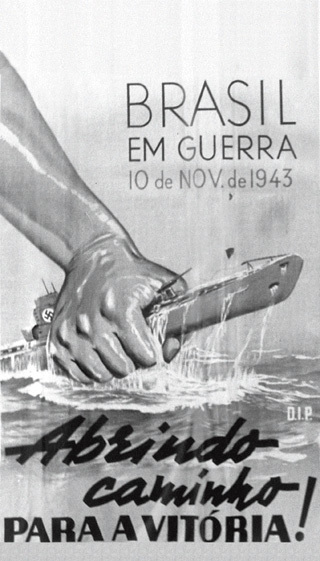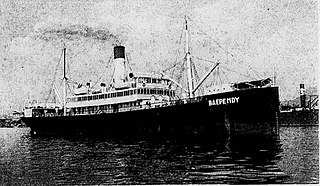
RFA Sir Bedivere (L3004) was a Landing Ship Logistic of the Round Table class. She saw service in the Falklands War, the Persian Gulf and Sierra Leone. In 2009, she was commissioned into the Brazilian Navy and renamed NDCC Almirante Saboia (G-25), where she saw service in Haiti.

The Brazilian Expeditionary Force, nicknamed Cobras Fumantes, was a military division of the Brazilian Army and Air Force that fought as part of Allied forces in the Mediterranean Theatre of World War II. It numbered around 25,900 men, including a full infantry division, liaison flight, and fighter squadron.
The Brazilian Navy is the naval service branch of the Brazilian Armed Forces, responsible for conducting naval operations.

USS Hermitage (LSD-34) was a Thomaston-class dock landing ship of the United States Navy. She was named for The Hermitage, President Andrew Jackson's estate just outside Nashville, Tennessee.

S Tikuna (S-34) is a Type 209 submarine of the Brazilian Navy. Built in the Brazilian Navy Yard in Rio de Janeiro (AMRJ), it was launched in March 2005 and incorporated into the Brazilian Navy on July 21, 2006, and then transferred to the Naval Operations Command. It is the fourth Brazilian Navy submarine made in Brazil and the largest ever built in the country. The name of this submarine is a tribute to South American indigenous tribe Tikuna inhabiting the region of the Upper Solimões, in the western part of the State of Amazonas.

Brazil officially entered World War II on August 22, 1942, when it declared war against the Axis powers, including Germany and Italy. On February 8, 1943, Brazil formally joined the Allies upon signing the Declaration by United Nations. Although considered a secondary Allied power, Brazil was the largest contributor from South America, providing essential natural resources, hosting strategic air and naval bases, participating in the Battle of the Atlantic, and deploying the
Brazilian Expeditionary Force to the Italian Campaign, the only South American country to send combat troops overseas.
SS Arabutan was the fifth Brazilian merchant ship to be sunk during World War II. At 21.10 hours on 7 March 1942, the German submarine U-155 fired a stern torpedo that hit the Arabutan after 102 seconds and caused it to sink in 13 minutes about 81 miles off Cape Hatteras, at 35.15N/73.55W.

Events in the year 1942 in Brazil.

Álvaro Alberto, Brazil's first nuclear-powered submarine, is the fifth unit of the Riachuelo-class based on the French Scorpène-class and is part of a strategic partnership signed between France and Brazil on 23 December 2008 that created the Submarine Development Program. The submarine was named after the former Vice Admiral and scientist Álvaro Alberto da Motta e Silva, who was the responsible for the implementation of the country's nuclear program. He also served as President of the United Nations Atomic Energy Commission between 1946–47, and as President of the Brazilian Academy of Sciences for two terms.

Riachuelo (S40) is a Brazilian Riachuelo-class submarine built for the Brazilian Navy by DCNS in Cherbourg and ICN in Itaguaí, Brazil.

Humaitá (S41) is a Brazilian Riachuelo-class submarine built for the Brazilian Navy by ICN in Itaguaí, and DCNS.

The Itaguaí Construções Navais S.A. known as ICN, is a Brazilian state-owned defence company specialized in naval-based platforms and naval nuclear engineering, founded on 21 August 2009. The company employs nearly 2,000 people.
The Brazilian Submarine Force Command, is the submarine force of the Brazilian Navy. The ComForS is one of the oldest commands of the Brazilian Armed Forces.

The Foca class, or simply F, was the first naval class of submarines operated by the Brazilian Navy. It consisted of the F1, F3 and F5 submarines designed by Italian naval engineer Cesare Laurenti and built in La Spezia, Italy. The name Foca comes from the Portuguese vessel of the class. The class was part of Brazil's 1906 naval program to acquire warships to modernize its navy. The submarines were acquired to serve as a training and maintenance platform for the crews, with few naval actions during the 19 years they were active. The navy incorporated the class on 17 July 1914 and, as a result, expanded its naval structure to house these new vessels, such as the creation of the first naval school for submariners and the incorporation of ships designed to support submarines only.

The Submarine Development Program (PROSUB) is a partnership signed between Brazil and France in 2008, with the objective of transferring technology for the manufacture of military vessels. It is a component of the Brazil's Defense Strategy to develop the country's naval power with the production of four conventional submarines and the first Brazilian nuclear-powered submarine. The program will make Brazil one of the few countries to have nuclear technology, alongside the United States, Russia, France, the United Kingdom, China, and India.

The Riachuelo class are a Brazilian class of diesel-electric and nuclear-powered attack submarines developed by the state-owned shipyard Itaguaí Construções Navais, based on the French Scorpène-class as part of the Submarine Development Program.
The Parnaíba (Parnahyba) was a Brazilian cargo ship sunk during World War II by the German submarine U-162 on May 1, 1942, while sailing east of Trinidad and Tobago in the Atlantic Ocean, carrying coffee, cocoa, castor bean oil, cotton, and other commodities.

The Araraquara was a Brazilian cargo and passenger ship, sunk on the night of August 15, 1942, by the German U-boat U-507, off the coast of the state of Sergipe.

The packet Baependi (Baependy) was a Brazilian cargo and passenger ship sunk on the night of August 15, 1942, by the German submarine U-507 off the coast of the state of Sergipe. She was the sixteenth Brazilian ship to be attacked, and her torpedoing was, until then, the greatest Brazilian tragedy of the Second World War, with 270 dead, surpassed only by the sinking of the cruiser Bahia, in 1945, in which around 340 men died.

Tonelero (S42) is the third unit of Riachuelo-class submarine built for the Brazilian Navy by ICN in Itaguaí, and DCNS.
















